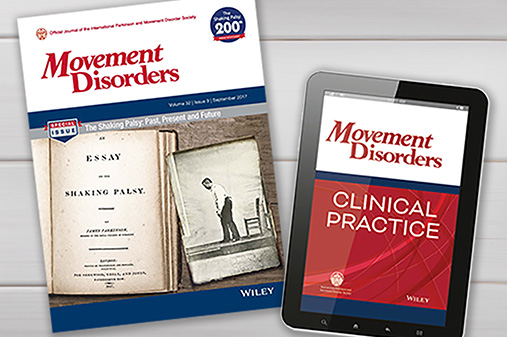The cholinergic contribution to freezing of gait in Parkinson’s disease
Dr. Michele Matarazzo: Hello and welcome to the MDS Podcast, the official podcast of the International Parkinson and Movement Disorder Society. I'm Michele Matarazzo, and today we'll be talking about one of the most challenging symptoms in Parkinson's disease, which is freezing of gait. And in particular, we a re going to talk about those cases that don't improve with dopaminergic medication.
View complete transcript
Join me is Dr. Nicolaas Bohnen, senior author of a recent paper published in Movement Disorders titled Cholinergic System Changes in Dopa-Unresponsive Freezing of Gait in Parkinson's Disease. Dr. Bohnen is professor of Radiology and Neurology at the University of Michigan, and also works at the Ann Arbor VA Medical Center.
And he's also a leading expert on neuroimaging and cholinergic function in Parkinson's disease. Nico, welcome to the podcast and thank you for being with us today.
Dr. Nicolaas Bohnen: It is my pleasure. Thank you.
Dr. Michele Matarazzo: Okay. So I would like to start with the clinical [00:01:00] part of this story. Freezing of gait is one of the most c hallenging and probably frustrating manifestations of Parkinson's disease, not just for patients, which of course are the ones affected by it, but also for clinicians. And while some patients respond to levodopa or to dopaminergic medication, others don't.
Or, a lot of patient who initially respond to levodopa end up not responding to levodopa. Now, can you briefly explain how common dopa unresponsive, freezing of gait is and why it is such a critical unmet need for our field?
Dr. Nicolaas Bohnen: Yeah, absolutely.
Yeah, so levodopa is the biggest miracle, that we have achieved in Parkinson's disease, but we should realize that the honeymoon with levodopa, if you take a rough number, plus or minus, is about five years. So initially, whatever dopaminergic medication you use. You're the excellent doctor, but after five years, when [00:02:00] the honeymoon starts to fade away and things become more serious, you no longer that miracle doctor because you're dealing with symptoms that simply L-DOPA does no longer or ineffectively treat.
And that can be dementia, which is actually one of the most debilitating complications, a non-motor symptom in Parkinson's. But also, falls and freezing of gait. We call them these midline axial motor impairments, and if you ask people about the quality of life and you take the Hoehn and Yahr staging schema from one stage, mild, to stage five, bedridden, it's the transition postur al instability develops at stage 2.5 and three, the people's quality of life really goes down. And then at the same time, when we see those balance and gait problems developing, it more or less goes hand in most patients with development of [00:03:00] cognitive impairment and then ending up in dementia. Initially freezing of gait may be present in a smaller subset of patients, but if you live long enough with Parkinson's and we have this long prospective cohort studies up to 20 years, up to 80% will have dementia as well as falls and freezing of gait.
And how do you treat that population? And that's where L-DOPA is failing you. And so that's the clinical unmet need we have in Parkinson's disease. Freezing of gait is very debilitating. Imagine you going to take a step and despite that, you try everything to you fail to do and one of the most important things we do in a life is so-called goal-directed motor behavior.
We stand up and we have a goal to move. There's a motivation to pick something up or do something, and then if you want to do that to lead an functionally [00:04:00] independent life, if you cannot move, that's really a serious problem that you're dealing with.
Dr. Michele Matarazzo: Great. Thank you for this background. It's really clear that b eing unable to walk affects and impacts severely the quality of life of our patients. And also as you were mentioning, the risk of falls. They have sometimes very severe consequences for them. Now it is clear to me why you wanted to study this.
But let me ask you, you were already touching a little bit of the next question, which is not everything is about dopamine in Parkinson's disease. There are other things. Now, why did you decide to study acetylcholine in freezing of gait? What is the evidence of the link between these two pieces of the puzzle of both Parkinson's disease.
Dr. Nicolaas Bohnen: Yeah, so first of all, there is actually significant previous literature t hat exposure to anti-muscarinic anticholinergic drugs is a big predictor for freezing of gait. And postmortem studies show that exposure [00:05:00] to anticholinergic medications is also associated w ith developing misfolded proteins from Alzheimer's disease like plaques and tangles.
And what we know about this advancing disease when levodopa is no longer your friend, is that there is increasing comorbidity of misfolded protein on top of the alpha-synuclein, that it's packed in the Lewy bodies, but also we see variable degree of Alzheimer's co pathology. And in a very naive and overly simplistic model.
When I was in medical school, they said that Parkinson's is a loss of dopamine, and then Alzheimer's disease is a loss of acetylcholine. And when I started my career u sing Cholinergic PET Imaging, one of the very first studies I did was actually compare Alzheimer's to Parkinson's, and not only Parkinson's with dementia, but Parkinson's without dementia with mild cognitive [00:06:00] impairment.
And guess what? The average loss of acetylcholine in the brain was even higher, believe it or not, except for hippocampus, in even patients with mild cognitive impairment in Parkinson's. What is the paradox is Alzheimer's disease only develop severe cholinergic losses in the very end stage of the disease.
So it's a late phenomenon in Alzheimer's, but it got all the attention of the literature. While we have been focusing for 60 years in dopamine-centric view of Parkinson's disease and simply forgetting about existing postmortem data dating back to the early 1980s, showing exactly what I also found in my in vivo imaging data. So it's nothing new. It simply was neglected.
Dr. Michele Matarazzo: So it's been there the whole time. We just, well, another difference is that now we have a tool to measure it better. And actually that links to my next question because of [00:07:00] course PET imaging to study the cholinergic system in the brain is long been used in the past, not only years, but decades.
But now you're using a different tracer, which is a little bit more m odern, which is the FEOBV Can you tell me a little bit more about that specifically and how it compares with other tracers that have been used in the past.
Dr. Nicolaas Bohnen: Yeah, so the other tracer of example, the cholinesterase PET ligands, remember the drugs we use for treating cognitive impairment and dementia is cholinesterase inhibitors. And these are complicated drugs with a lot of problems. So we'll not go into that in detail, but the first thing to do, so if you want to measure a still cholinesterase in the brain was actually ready label one of these medications or derivatives and that's what they did like 25 or 30 years ago.
And what you see then is when you look in a still cholinesterase PET scan. The most [00:08:00] intense activity of acetylcholine nerve terminals in the brain is the same as the dopamine scan is in the basal ganglia. It's actually relatively low in the cortex where everybody pays attention to them, but the basal ganglia is the big sleeping elephant in the room.
Again, it very intense in terms of nerve terminal activity. The problem with cholinesterase inhibitors, and unless you do complicated technology with PET scans, inserting arterial line and sample blood parameters, which many patients don't like, if you do that you cannot reliably quantify the most important, at least the most intense structure in the brain, the basal ganglia, and for that same reason, the basal ganglia and the cerebellum.
So it's really a handicap. So what people have done is when you look at the nerve terminal, most that we know that, neurotransmitter synthesized. But then, b [00:09:00] efore the neurotransmitter can be released to the synaptic left, it needs to be packaged into small vesicles that are present in the presynaptic nerve terminal cytoplasm, and are transporters in the cytoplasm bond on those vesicles, we call them the vesicular transporters.
The access for dopamine, the access for, let's say every neurotransmitter we use, we need to package an in vesicle. So the one for the acetylcholine is called the vesicular acetylcholine transporter. And it simply tells the capacity, how much acetylcholine, we can pack an a vesicle. So once the vesicle is released into the cleft.
The more acetylcholine is in the vesicles, the more acetylcholine you can release. But compared to other ligands that focus on receptors, this is a very stable marker that doesn't change much. If you take even, let's [00:10:00] say a medication that may impact the release it, it's only minimally affected. So it's a very reliable m arker is if you want if you will, the density of the presynaptic nerve terminals, then go with vesciular transporter PET scan. We have them for dopamine, for the monoamines, we have acetylcholine, for norepinephrine, et cetera.
Dr. Michele Matarazzo: And you had the possibility of looking into those very relevant areas of the brain, especially for Parkinson's disease, at least as, as as we know it how important those areas, such as the striatum, for example, is for Parkinson's. That's fantastic. Now let's get into the results a little bit.
So you found a distinct pattern of cholinergic denervation in dopa-unresponsive freezing of gait group as compared to the dopa responsive one. Can you walk us through the main regions affected and how this pattern differs from the people who the had freezing, but did respond to levodopa?
Dr. Nicolaas Bohnen: Yeah, indeed. So [00:11:00] in our study we compare patients who had levodopa resistant freezing of gait compared them to those who still responded to levodopa. So you really can zoom in on the areas that are significant between the groups. And this included the insular, the hippocampus, the fimbria of hippocampus, the metathalamus, particularly the lateral geniculate nuclei. Then we had the posterior cingulate, the anterior ventral nucleus of the thalamus, also known as part of the motor thalamus, if you will, and then the putamen and left mid-temporal region. If you look at this region, a nd if you're going to divide the cortex, if you will, in limbic versus neocortical or paralimbic, this is mainly limbic and paralimbic structures.
So like the hippocampus, for example, posterior cingulum. And insula is your key paralimbic [00:12:00] structures and what we know from human brain studies is the most dense cholinergic innovations by the nucleus basalis of Meynert are the limbic and paralimbic structures, and what they do is the function of acetylcholine, if you want to put it in simplistic terms, it's like looking for meaningful clues in your life. Example, if you have a dog, when you're eating, the dog pays attention, is really focused. To the point, t hat the dog may get some food, for example, that's a meaningful clue for the animal. But we do more or less the same thing in life, and we look for meaningful clues that are relevant for us, and we need to pay selective attention to those and ignore all the other noise of sensory stimuli where we live in.
And that's the function of acetylcholine and is paying attention, filtering out noise so that we have goal directed behaviors. This is what I want and I detected a cue. Let's [00:13:00] pursue it. Let's get up and moving. So this goal directed motor behavior is very important in life and this is actually where the limbic cortex and paralimbic cortex is due is they put this level of motivation to the sensory input.
It's more like a motivational, sensory processing structures that I say, this is my what I want to do. I need my hippocampus. The only way I have to move with my navigation. And then I go there and I achieve my goal. And that's actually most of what we do in life. We have goals.
Dr. Michele Matarazzo: This is actually very interesting and I have a few follow up questions to this. So the first one is when my mind think about the cholinergic function in the brain and what happens in Parkinson's disease. There has always been this link between, you were mentioning before the Nucleus Basalis of Meynert, but more with the cognitive part and maybe the PPN more with [00:14:00] the gait problems.
Now you're talking about the Nucleus Basalis of Meynert with the freezing of gait. Are you implying that he freezing of gait is more of a cognitive problem, or maybe we've been looking at this wrong all along. And and there is no such a clear cut distinction between, Nucleus Basalis of Meynert, cognition, PPN, gait, and this is a much more complex thing.
Dr. Nicolaas Bohnen: Yeah. So the same is a philosophical question. Is a fall a motor problem or is a fall a cognitive problem? And the answer is we cannot be dualistic here. We cannot go back several centuries ago and have dualism in medicine. What we see is this is really fully integrated cognitive and motor sensory and emotional processing in goal directed behaviors.
And this is different from automatism of movements. We can take like in locomotive region and stimulate a locomotive region. Let's in a cerebellum or the PPN or the subthalamic nucleus. Or even the spinal cords and [00:15:00] we get automatic stepping. You can even take the cortex away in cats they've done this, these cats without the brain.
And if you stimulate those areas and keep the cat alive, they still walk for you. But that's a automatism of movements. But this is quite different from goal directed behaviors. You need to input all that information, the motivation to move. You need to make sure that in a busy indoor living setting, you don't bump into things, bump into other people.
You watch out for the cat in front of your feet, so you need to put that information in for safe goal directed and motivation, and that's no longer automatic. And that's the big difference between those basic locomotive center. So in this aspect, with freezing of gait and if you look at the regions, we find that the refractory, it's the areas that we need for cognitive motor and multisensory processing and at the same time put an emotional valence [00:16:00] to it. You have a vigor, a reason, motivation to move, and the processing level happens in interactions with the cortex, but the striatum plays a role. The complex thing is you say, why don't you see that in terms of taking striatum? When we compare freezers to non freezers, we see all these changes being abnormal in at the cholinergic level, in the striatum very extensively.
But this is the difference between nonresponsive versus responsive freezing, and it's no longer the emphasis on this striatum. It's really on this higher cortical level multisensory cognitive motor tensional integration. Mix it in with emotional factors, even fear of falling plays also a role in freezing of gait and that happens at the higher cortical levels.
Dr. Michele Matarazzo: Great. That, that makes a lot of sense. And of course, we started this because we started this conversation from [00:17:00] the clinical part. I would like to go back to that. Do you think that the results that you're showing can help us finding a way to help the patients who are suffering from this manifestations of Parkinson's?
Dr. Nicolaas Bohnen: Yeah, so indeed I think, what we as clinicians can do is, number one is, and it's very easy, it's simply de-prescribing anything that has anticholinergic metrics that pass the blood brain barrier. Let's say thing about these antimuscarinic medications we use for the bladder. There are a number of them that simply don't cross or very little cross the blood brain barrier, switch them from selective peripheral antimuscarinic drug that can do miracles already in improving the cholinergic system. A lot of medications we use in medicine like warfarin, Lasix, antidepressants have anticholinergic side effects, and if you don't know that, that they even have [00:18:00] anticholinergic side effects, people keep on prescribing them.
But I have to alert internal medicine doctors about it and then give them advice to take away this medication. That's the low hanging fruit. Then the question is, what about cholinesterase inhibitors? And I mentioned cholinesterase inhibitors are complex drugs. They're simply in a non-specific way, increase the amount of acetylcholine at the synaptic cleft, but they both s timulate and inhibit certain presynaptic and postsynaptic receptor, so you have a dilution of effects. It's not really primed to one specific receptor subtype, but I did this studies myself of years ago, I mentioned that study in Alzheimer's and Parkinson's that I compare them and we did a trial and we gave the patients donepezil and the FDA approved donepezil based on 100% blockage of acetylcholinesterase in the [00:19:00] red blood cells. What I found in the studies, it only got in the brain at the best in 20-25% in patients in the brain. And if the a verage blocking was more than 25%, let's say 30%. Then I saw cognitive benefits on attention memory, but anybody below, let's say 22 had zero benefits. We use medications that weakly get in the brain and that are also non-selective.
So there is actually, and that's, I very happy to see the new literature expanding. We have no recent approval in the US not in neurology, but in psychiatry to treat patients with psychosis, with schizophrenia, with a muscarinic one and muscarinic four agonist and they were smart.
They combine that with a medication trospium that blocks the peripheral muscarinic receptors, for example, on the bladder. But it doesn't cross the blood [00:20:00] brain barrier or very little. And that is an approach to maximize a specific drug that acts on specific muscarinic receptor subtypes. Get it in the brain and don't worry about peripheral dose limiting side effects that we see, for example, with cholinesterase inhibitors.
Another example, which is my hidden pearl in the literature that I found, and probably many of the listeners are also aware of it, if I have a patient that doesn't respond to levodopa anymore with freezing gait, I go to the rotigotine patch. And the rotigotine patch is a dopamine one., till partially D2, D3, dopamine receptor agonist.
But studies also have shown that if you use measures of acetylcholine in the brain, for example, with TMS transcranial magnetic stimulation techniques to see how certain [00:21:00] pulses are being transmitted in the brain and quantify that rotigotine actually improves this processing at the cholinergic level in the brain that many people don't even realize.
So that is a drug plays a role, but we should not even forget about a n old drug done by Kathy Chung and Jane Nut , in Oregon at Portland, Oregon, years ago, 2010, where they used Anepecel and frequently falling patients with Parkinson's disease. They had a 50% reduction in falls.
And remember, a lot of falls in Parkinson's are due to freezing of gait. That's actually one of the main reasons to fall. It's only in patients with frequent falls. And they did a study with another promising drug from Takeda called TAK-0 71, which is an muscarinic type one receptor asteric modulator in Parkinson's disease where they even had a predictor [00:22:00] for falls called gait variability, how irregular is your gait and also had as a secondary outcome cognition, and the study failed to find a reduction in of this drug.
For the gait fall predictor, but they included patients who had fallen at least once per year, and the study was under power to look at patients who had multiple falls and probably were have freezing of gait. But interestingly, this drug significantly improved cognition and globally and particularly in e xecutive functions including special navigation task and divided attention inhibition tests.
So this is all in the literature, just published in German neurology in earlier this year. But this is the line of medications that now coming to the clinic those selective muscarinic agonist. And for example, I mentioned xanomeline, the M1, M4 [00:23:00] agonist, we can actually treat them.
For, we even have all drugs, varenicline, and we did a study with Varenicline that stimulates alpha4beta2 nicotine receptors in the brain in Parkinson's. And we didn't look for freezing of gait, but we looked, for example, at a difference of stepping while you're doing cognitive motor dual tasking and actually improved on that.
So Varenicline is an existing drug that potentially could be repurposed to test in clinical trials in freezing of gait. And last but at least is a drug from 2014 by Andrew Lieberman, where they had nicotine bitartrate. And he said, what is nicotine bitartrate. You can actually, in the US at least go to a gas station and buy it in e-cigarettes.
I'm not promoting them here, but just clear in the nicotine gums and nicotine, whatever they use for nicotine preparations, [00:24:00] they use it clinically for anti-smoking. But he did the study. Have a dose with Al that's important with nicotine. It needs to be versatile. Otherwise, your receptors get misregulated.
Nicotine, building up from a low dose of 10 weeks, four per day. To I believe, 10 weeks. And what you found was they saw a significant reduction in the number of falls and the freezing episodes. So in other words, we don't have to wait for fancy new drugs. If you're willing to commit funds for repurposing, there is some low hanging fruit here.
Dr. Michele Matarazzo: That leads me to my probably last question. Are you going to do these trials? Or who is going to do these trials?
Dr. Nicolaas Bohnen: Yeah. And that's the big problem and who will fund that. Who will fund trials. That's if you have a pharmaceutical company, they have a self-interest to fund it for already repurposing, you need to have charity or foundation funding and with the [00:25:00] nicotine, you have to be careful that, because we know that Parkinson's patients have a propensity for sometimes addiction.
That, for example, with levodopa a few percent of patients. So we have to watch out with the nucleus accumbens and dopamine. And also remember when we speak about acetylcholine, it's not a separate box from dopamine. Somebody would use nicotine. You stimulate dopamine actually. So dopamine are still choline and not separate circuitry.
They're actually at the molecular level. They interact with each other. They're like two partners in a dance.
And what we see in essence that early on in Parkinson's disease, acetylcholine, upregulates, this is an old hypothesis from 60 years ago. We call that the see-saw of balance, but then later in disease, we showed the studies that initially in Parkinson's, this higher than normal acetlycholine level, including the basal ganglia and the forebrain, et cetera.
But then we lose that compensation. And [00:26:00] that's when those problems start kicking in as still coding can no longer compensate.
Dr. Michele Matarazzo: And do you foresee PET imaging, like FEOBV, for example, as as a criteria to include or not include, or to treat or not treat patients with this compounds, novel compounds or repurposed compounds.
Dr. Nicolaas Bohnen: Yeah. It depends on the molecular target of your treatment. I would go, if you have a muscarinic, I would go with a muscarinic receptor, for example or nicotine receptor. And because we have selective subtype, selective muscarinic. As well as nicotinic PET ligand. And so I would go with the molecular target at have target engagement, but you could use the technique for preselection of patients to make sure they're not hyper then normal that the ones who are compensating, I don't want to give this some medications to where the acetlycholine is upregulated.
You have to select those who [00:27:00] have become hypo cholinergic.
Dr. Michele Matarazzo: Thank you very much. Is there anything else you want to share with our listeners?
Dr. Nicolaas Bohnen: No, that's all. I would like to thank you for this interview and thank you, the listeners for listening.
Dr. Michele Matarazzo: Thank you so much for joining us today and for walking us through this very interesting study. And for those of you interested, remember that the full paper is available in Movement Disorders. Thanks again for tuning in into the MDS podcast. See you next time. [00:28:00]

Nicolaas I. Bohnen MD, PhD
University of Michigan & Ann Arbor VA
Ann Arbor, MI, USA









